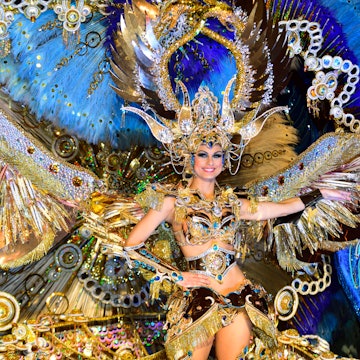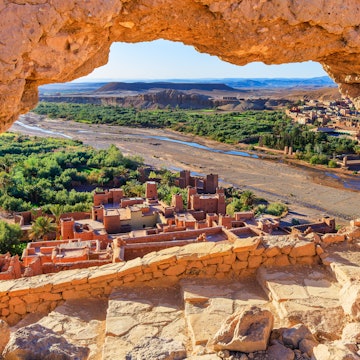
Visit Cartagena, Spain, in September for ancient battle reenactments and costumed revelry

Aug 18, 2023 • 5 min read

Each September, the Fiestas de Carthagineses y Romanos bring historical reenactments and festive parties to the city of Cartagena, Spain © Q77photo / Shutterstock
The slope of the Batel, by Muralla de Carlos III, is a sea of blue and red tunics as the Carthaginian and Roman armies face off against one another.
The first group of fighters – armed with spears, their faces fearsome painted masks of blue and white – let out a tremendous roar, their archer women ready to let loose a cloud of arrows. The red-cloaked Romans stand impassively in formation, their crested helmets glinting in the sun, waiting for General Scipio to give the Spanish equivalent of the order, “On my signal, unleash hell!”
The audience watches, rapt, as the hillside becomes a melee of swords clashing against shields, the air thick with war cries, until the outnumbered Carthaginians are finally defeated. The Roman troops march in triumph to the Festival Camp, whose name is then changed from Qart-Hadasht to Carthago Nova to mark their victory.
The festival is in full swing.
The reenactment of the Battle for Qart-Hadasht from the Second Punic War (218–208 BCE) is one of the highlights of the Fiestas de Carthagineses y Romanos (Festival of Carthaginians and Romans) that take place in Cartagena, Murcia, in the second half of September. The festivities put the Spanish city in full party mode, as it celebrates its historic roots.
The second-oldest settlement on the Iberian Peninsula, the port of Qart-Hadasht was founded by the Carthaginians in 223 BCE. Yet the Carthaginians only managed to hold on to it for 18 years: when the legendary Carthaginian commander-in-chief Hannibal set off to march across the Alps toward Rome, elephants and troops in tow, the Roman general Scipio took advantage of his absence and attacked the city from the sea in 209 BCE, scoring a surprise win. Every year, the clash is reenacted – minus the elephants.

The festival is a wonderful time to experience Cartagena, when its dense concentration of historic sites come to life. Most of all, it’s a riveting spectacle, with hundreds of Roman and Carthaginian troops in full battle gear parading past the fashion boutiques, bars and beautiful art nouveau buildings along Calle Mayor; fun historical reenactments; and plenty of non-historical audience participation in games and contests at the Festival Camp next to the Estadio Cartagonova (home to FC Cartagena).
Attendance doesn’t require much advance planning, since most events are free (while there are charges for seats at some events, you can always stand for free). The festival kicks off on the third Friday in September with the Arrival of the Sacred Fire by boat, which is then lit on by a Roman priestess on the Cerro del Molinete, one of Cartagena’s five hills.
If you can’t come for the full 10 days, memorable events take place over the course of the festival. On Monday, the wedding of Carthaginian general Hannibal and Iberian princess Himilce is celebrated with gusto at the Festival Camp. Revelers can also choose to “get married” in a Carthaginian or Celtic wedding. The Carthaginian and Roman streets of the Festival Camp host competitions and games for children on Wednesday; at night, the Roman part of the camp parties late into the night during the Feriae Latino. Thursday sees the Carthaginian armada disembark at the port and the Carthaginian troops parade towards the Festival Camp, marking Hannibal’s march on Rome.
The festival saves the best for last: on the second Friday, the (non-historical) rowing race in the harbor between Carthaginians and Romans is followed by the arrival of the Roman Armada and the epic Battle for Qart-Hadasht. The second Saturday is your only chance to see the Romans and Carthaginians march together in their battle finery, while the final day – the second Sunday – is dedicated to the Great Roman Circus (the only event for which you need advance tickets), with chariot races and gladiatorial fights held in a portable bullring. Afterward, the Victory of Rome is staged, the priests and priestesses extinguish the Sacred Fire, and a grand fireworks display over the harbor signals the end of the festival.

What to see in Cartagena, Spain
In between joining festive processions while dressed in your finest Roman or Carthaginian dress, it’s well worth exploring Cartagena’s rich palimpsest of historical remains, which date back to the Roman and Carthaginian eras. Start with the Teatro Romano – one of the largest amphitheaters in the Roman world, excavated in the 1990s, and accessed via a well-designed, minimalist museum on Plaza del Ayuntamiento that displays a careful selection of statuary, ceramics and ritual objects.
Head north to the Foro Romano on Molinete hill for a stroll around the Roman forum, dating from the 1st century BCE, past remains of wealthy Romans’ villas, complete with fragments of wall paintings, and the thermal baths. Several blocks east, peruse an intact section of the old Punic wall at Muralla Púnica, part of the city’s Carthaginian legacy. Finally, head south to the port that led the Carthaginians to establish a city here in the first place, and marvel at a wealth of amphorae, coin hoards and other ancient treasures recovered from the depths at the striking National Museum of Underwater Archaeology.
Where to stay in Cartagena, Spain
It's easy to arrange your stay in Cartagena so that you’re in the thick of the action, especially since the vast majority of the hotels are conveniently clustered in the compact Old Town. Most festivities take place in the Old Town’s Plaza del Ayuntamiento and Plaza de San Anton before proceeding to the Festival Camp across the river.
Stay at the contemporary, business-style NH Cartagena to be a stone’s throw both from the harbor and the Plaza del Ayuntamiento; in the boutique La Casa de las Flores for a blend of historical features and creature comforts; or wallet-friendly B&B Hotel Cartagonova for quick access to Plaza de San Antón.
Where to eat in Cartagena, Spain
For full immersion, there are Roman-themed food tents at the Festival Camp where you can fill your belly with grilled meats and wine. Aside from that, Old Town has a dense concentration of restaurants and tapas bars. Many are just off the Calle Mayor procession route, including the atmospheric El Barrio de San Roque, which excels at fresh fish dishes and stews. CafeLab serves the city’s best coffee, plus brunch dishes in a spectacular centuries-old building, while the traditional tapas (tortilla de camaron, gazpacho, cazón adobo, sardinas) at Albedrío really shine. For a truly special meal that makes the most of locally sourced, seasonal ingredients, complemented by a superb wine list, seek out Michelin-starred Magoga.















